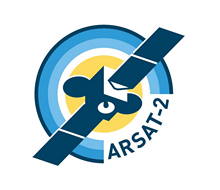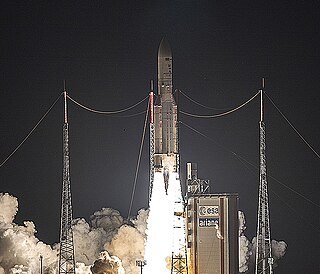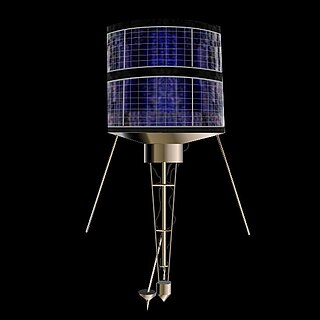 W
WArabsat-6A is a geostationary communications satellite operated by Arabsat. The satellite was built by Lockheed Martin Space Systems on a modernized A2100 bus. The satellite was successfully launched from Kennedy Space Center LC-39A aboard Falcon Heavy on April 11, 2019.
 W
WARSAT-2 is a geostationary communications satellite operated by ARSAT and built by the Argentine company INVAP. It was launched from French Guiana alongside Sky Muster satellite using an Ariane 5ECA rocket on September 30, 2015 at 20:30hs UTC, becoming the 400th satellite to be launched by Arianespace. It is licensed to be located at 81° West longitude geostationary slot. ARSAT-2 is the second geostationary satellite built in Argentina, after ARSAT-1. Structurally and mechanically it is a copy of the ARSAT-1, the only difference being the payload and thus it has different antenna configuration.
 W
WCFESat, the Cibola Flight Experiment Satellite, examines radio spectra for ionospheric and lightning studies, using field-programmable gate arrays (FPGAs). As well as science observation, the mission aims to show use of reconfigurable FPGAs to work in the radiation environment of low Earth orbit.
 W
WInmarsat-4A F4, also known as Alphasat and Inmarsat-XL, is a large geostationary communications I-4 satellite operated by UK based Inmarsat in partnership with the European Space Agency. Launched in 2013, it is used to provide mobile communications to Africa and parts of Europe and Asia.
 W
WThe KAUR was a very successful satellite bus designed and manufactured by ISS Reshetnev. It is a pressurized bus originally developed in the 1960s, it has been used from low Earth Orbit to medium Earth orbit and even to GEO. It has four different generations and its different versions have been used from civilian communications to satellite navigation.
 W
WKoreasat 5A is a South Korean communications satellite operated by KT SAT, a subsidiary of KT Corporation. On 30 October 2017, it was launched on Falcon 9 rocket.
 W
WKoreasat 7 is a South Korean communications satellite operated by KT SAT, a subsidiary of KT Corporation.
 W
WKosmos-2251,, was a Russian Strela-2M military communications satellite. It was launched into Low Earth orbit from Site 132/1 at the Plesetsk Cosmodrome at 04:17 UTC on 16 June 1993, by a Kosmos-3M carrier rocket.· The Strela satellites had a lifespan of 5 years, and the Russian government reported that Kosmos-2251 ceased functioning in 1995. Russia was later criticised by The Space Review for leaving a defunct satellite in a congested orbit, rather than deorbiting it. In response, Russia noted that they were not required to do so under international law.· In any case, the KAUR-1 satellites had no propulsion system, which may be required for deorbiting. ·
 W
WThe Laser Communications Relay Demonstration (LCRD) is a NASA mission that will test laser communication in space for extremely long distances.
 W
WMEASAT-3 is a Malaysian communications satellite which was successfully launched on 11 December 2006 from the Baikonur Cosmodrome in Kazakhstan.
 W
WMEASAT-3b is a communications satellite which MEASAT and Trans Media operates in geosynchronous orbit at 91.5 degrees east longitude, co-located with MEASAT-3 and MEASAT-3a, with orbital period of 1436.1 minutes and orbital speed of ~3.08 km/s. It was built by Astrium, based on the Eurostar spacecraft platform, with an investment of approximately MYR1.25bn ($370m), and the 5th MEASAT satellite in orbit. Its weigh 5,897 kilograms at liftoff and is 6.6 by 2.8 by 2.3 meters in dimensions in its stowed config and spanned across 39.4m in orbit. It is three-axis stabilized and has 48 Ku band transponder, more than double the current Ku-band capacity operated by MEASAT, which are used for the expansion of video and data services and enhances support to Asia's premium direct-to-home (DTH) and video distribution neighbourhood across Malaysia, South Asia (India), Indonesia and Australia, serving more than 18 million households. It has been designed to support a fourth market. Australian satellite operator NewSat Ltd. announced in February 2012, that an undisclosed number of Ku-band transponders will be leases and marketed as Jabiru 2. Its mission duration lasted more than 15 years. MEASAT-3b technical frequency EIRP test are available in LyngSat website.
 W
WThe Multiple Paths, Beyond-Line-of-Sight Communications (MUBLCOM) satellite, built for the Pentagon's Defense Advanced Research Projects Agency, was launched in May 1999 by a Pegasus. Its mission was to demonstrate a capability to provide space-based digital voice and data communications to combat forces or commercial users that were previously considered out of range of standard radio communications systems.
 W
WOrbita is a Soviet-Russian system of broadcasting and delivering TV signals via satellites. It is considered to be the first national network of satellite television.
 W
WSirius FM-1, also known as Radiosat 1, was an American communications satellite which was operated by Sirius XM Radio, previously Sirius Satellite Radio. It was constructed by Space Systems Loral and was based on the LS-1300 satellite bus. Launch occurred on 30 June 2000, at 22:08 GMT. The launch was contracted by International Launch Services, and used a Proton-K/DM3 carrier rocket flying from Site 81/24 at the Baikonur Cosmodrome.
 W
WSirius FM-2, also known as Radiosat 2, was an American communications satellite which was operated by Sirius XM Radio, previously Sirius Satellite Radio. It was constructed by Space Systems Loral and was based on the LS-1300 satellite bus. Launch occurred on 5 September 2000, at 09:43 GMT. The launch was contracted by International Launch Services, and used a Proton-K/DM3 carrier rocket flying from Site 81/23 at the Baikonur Cosmodrome.
 W
WSirius FM-3, also known as Radiosat 3, was an American communications satellite which was operated by Sirius XM Radio, previously Sirius Satellite Radio. It was constructed by Space Systems Loral and was based on the LS-1300 satellite bus. Launch occurred on 30 November 2000, at 19:59 GMT. The launch was contracted by International Launch Services, and used a Proton-K/DM3 carrier rocket flying from Site 81/23 at the Baikonur Cosmodrome.
 W
WSirius FM-5, also known as Radiosat 5, is an American communications satellite which is operated by Sirius XM Radio. It was constructed by Space Systems Loral, based on the LS-1300 bus, and carries a single transponder designed to transmit in the NATO E, F and I bands. It is currently being used to provide satellite radio broadcasting to North America.
 W
WTDRS-10, known before launch as TDRS-J, is an American communications satellite which is operated by NASA as part of the Tracking and Data Relay Satellite System. It was constructed by the Boeing Satellite Development Center, formerly Hughes Space and Communications, and is based on the BSS-601 satellite bus. It was the third and final Advanced TDRS, or second-generation Tracking and Data Relay Satellite, to be launched.
 W
WTDRS-11, known before launch as TDRS-K, is an American communications satellite which is operated by NASA as part of the Tracking and Data Relay Satellite System. The eleventh Tracking and Data Relay Satellite is the first third-generation spacecraft.
 W
WTDRS-12, known before launch as TDRS-L, is an American communications satellite operated by NASA as part of the Tracking and Data Relay Satellite System. The twelfth Tracking and Data Relay Satellite, it is the second third-generation spacecraft to be launched, following TDRS-11 in 2013.
 W
WTelstar 19V (Telstar 19 Vantage) is a communication satellite in the Telstar series of the Canadian satellite communications company Telesat. It was built by Space Systems Loral (MAXAR) and is based on the SSL-1300 bus. The satellite was designed to provide additional capacity over the North Atlantic region. As of 26 July 2018, Telstar 19V is the heaviest commercial communications satellite ever launched, weighing at 7,076 kg (15,600 lbs) and surpassing the previous record, set by TerreStar-1 (6,910 kg/15230lbs), launched by Ariane 5ECA on 1 July 2009.
 W
WUSA-195, or Wideband Global Satcom 1 (WGS-1) is an American military communications satellite operated by the United States Air Force as part of the Wideband Global Satcom programme. Launched in 2007, it was the first WGS satellite to reach orbit. It is stationed at a longitude of 174.8° east.
 W
WUSA-204, or Wideband Global Satcom 2 (WGS-2) is an American military communications satellite which is operated by the United States Air Force as part of the Wideband Global Satcom programme. Launched in 2009, it was the second WGS satellite to reach orbit, and operates in geostationary orbit at a longitude of 60° east.
 W
WUSA-211, or Wideband Global Satcom 3 (WGS-3) is an American military communications satellite operated by the United States Air Force as part of the Wideband Global Satcom programme. Launched in 2009, it was the third WGS satellite, and final Block I spacecraft, to reach orbit. It is stationed at 12° west in Geostationary orbit.
 W
WUSA-243, also known as WGS-5, is an American military communications satellite. It was the fifth satellite to be launched as part of the Wideband Global SATCOM program, and the second Block II spacecraft.
 W
WUSA-244, or Wideband Global Satcom 6 (WGS-6) is an American military communications satellite operated by the United States Air Force as part of the Wideband Global Satcom programme. Launched in 2013, it was the sixth WGS satellite to reach orbit. It is stationed at a longitude of 135° west, in geostationary orbit. WGS-6 was procured by the Australian Defence Force for the US Air Force, in exchange for participation in the programme.